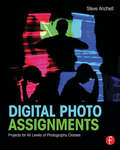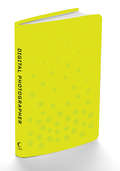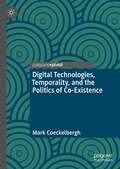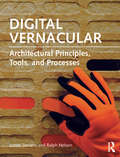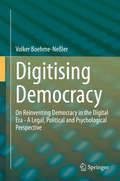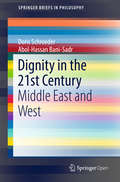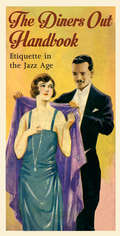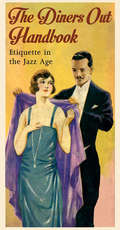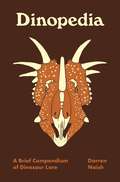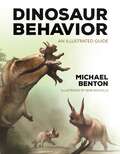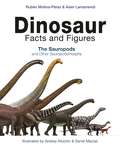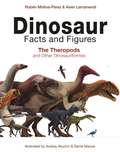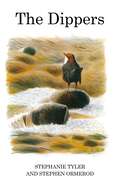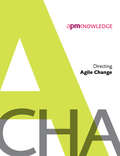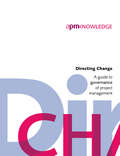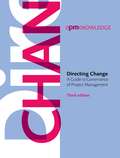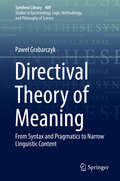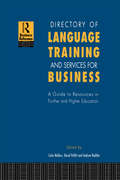- Table View
- List View
Digital Photo Assignments: Projects for All Levels of Photography Classes (Photography Educators Series)
by Steve AnchellThis collection of more than 40 photo assignments is designed to help all students—from beginning freshmen to experienced seniors—improve or reinvigorate their work and reach their full potential as photographers. Whether you are building a syllabus for your first photography class, revitalizing assignments for your students, or looking to add DSLR video, workflow, or color correction to your class, you will find a wealth of ideas in this wonderful working guide. The assignments begin with using the camera, and progress through learning composition and lighting, working in genres, building a portfolio and more.
Digital Photographer
by CollinsA unique and stylish gift in a smart, textured rubber binding, with an elasticised band. Aimed at the digital photographer on the move, it’s full of advice on getting the best shots when you’re out and about – whether on holiday, photographing fast-moving sports or capturing exotic landscapes.
Digital Technologies, Temporality, and the Politics of Co-Existence
by Mark CoeckelberghOur digital existence is hurried and fast. We are tied to the present, or perhaps we are not present enough: immersed in digital social media and processes by artificial intelligence, we are hardly present to ourselves and to others, and feel alienated from nature. We are also made to fear climate change and the end of humanity. How can we live a good life and give meaning to our lives under these conditions? How can and should we co-exist today?Using process philosophy, narrative theory, and the concept of technoperformances, this book analyzes how digital technologies shape our relation to time and our existence, and discusses what this means in the light of climate change and new technologies such as AI. In dialogue with contemporary philosophy of technology and media theory and asking original questions about finding common times in what it calls the “Anthropochrone”, it proposes a conceptual framework that helps us to understand how we (should) exist and relate to time today.
Digital Vernacular: Architectural Principles, Tools, and Processes
by James Stevens Ralph NelsonDigital Vernacular addresses the why and how of digital fabrication in hundreds of step-by-step color images, illuminating a set of working principles and techniques that join theory with practice. Authors James Stevens and Ralph Nelson reconcile local traditions and innovations with globally accessible methods and digital toolsets. By combining ethics with hardware, the book will root you in the origins of making, ensuring a lasting and relevant reference for your studio practice. The book opens with the origins and principles of the digital vernacular, then outlines digital vernacular tools including computer numerically controlled (CNC) mills, laser cutters, and 3D printers. You'll even learn to create your own digital fabrication tools out of inexpensive materials. The book concludes with the processes of the digital vernacular, including techniques for removing, joining, forming, and adding. A companion website at make-Lab.org hosts additional step-by-step processes and project outcomes.
Digital Vernacular: Architectural Principles, Tools, and Processes
by James Stevens Ralph NelsonDigital Vernacular addresses the why and how of digital fabrication in hundreds of step-by-step color images, illuminating a set of working principles and techniques that join theory with practice. Authors James Stevens and Ralph Nelson reconcile local traditions and innovations with globally accessible methods and digital toolsets. By combining ethics with hardware, the book will root you in the origins of making, ensuring a lasting and relevant reference for your studio practice. The book opens with the origins and principles of the digital vernacular, then outlines digital vernacular tools including computer numerically controlled (CNC) mills, laser cutters, and 3D printers. You'll even learn to create your own digital fabrication tools out of inexpensive materials. The book concludes with the processes of the digital vernacular, including techniques for removing, joining, forming, and adding. A companion website at make-Lab.org hosts additional step-by-step processes and project outcomes.
Digitising Democracy: On Reinventing Democracy in the Digital Era - A Legal, Political and Psychological Perspective
by Volker Boehme-NeßlerThis book argues that in the digital era, a reinvention of democracy is urgently necessary. It discusses the mounting evidence showing that digitalisation is pushing classical parliamentary democracy to its limits, offering examples such as how living in a filter bubble and debating with political bots is profoundly changing democratic communication, making it more emotional, hysterical even, and less rational. It also explores how classical democracy involves long, slow thinking and decision processes, which don’t fit to the ever-increasing speed of the digital world, and examines the technical developments some fear will lead to governance by algorithms.In the digitalised world, democracy no longer functions as it has in the past. This does not mean waving goodbye to democracy – instead we need to reinvent it. How this could work is the central theme of this book.
Dignity in the 21st Century: Middle East and West (SpringerBriefs in Philosophy)
by Doris Schroeder Abol‐Hassan Bani-SadrThis book is open access under a CC BY license.This book offers a unique and insightful analysis of Western and Middle Eastern concepts of dignity and illustrates them with examples of everyday life.Dignity in the 21st Century - Middle East and West is unique and insightful for a range of reasons. First, the book is co-authored by scholars from two different cultures (Middle East and West). As a result, the interpretations of dignity covered are broader than those in most Western publications. Second, the ambition of the book is to use examples from everyday life and fiction to debate a range of dignity interpretations supplemented by philosophical and theological theories. Thus, the book is designed to be accessible to a general readership, which is further facilitated because it is published with full open access. Third, the book does not defend one superior theory of dignity, but instead presents six Western approaches and one based on the Koran and then asks whether a common essence can be detected. The answer to the question whether a common essence can be detected between the Koranic interpretation of dignity and the main Western theories (virtue, Kant) is YES. The essence can be seen in dignity as a sense of self-worth, which persons have a duty to develop and respect in themselves and a duty to protect in others. The book ends with two recommendations. First, given the 7 concepts of dignity introduced in the book, meaningful dialogue can only be achieved if conversation partners clarify which variation they are using. Second, future collaborations between philosophers and psychologists might be helpful in moving theoretical knowledge on dignity as a sense of self-worth into practical action. The “scourges” of a sense of self-worth and dignity are identified by psychologists as violence, humiliation, disregard and embarrassment. To know more about how these can be avoided from psychologists, is helpful when protecting a sense of self-worth in others.
The Diners out Handbook: Etiquette In The Jazz Age (Old House Ser.)
by Alfred H. MilesThis charming pocket handbook is a complete guide to the manners, customs and etiquette of the glamorous '20s. Each chapter gives detailed instructions for a specific type of social event: what to expect, how to dress, suggested yarns for the raconteur and instructions for deft self-expression. As lively and amusing as it is useful, this is an expert reproduction of a vintage, Gatsvy-era guide to courtesy, style and elegance in the age that redefined them. *This is a faithful facsimile edition, and may contain terms offensive to some readers.*
The Diners Out Handbook: Etiquette in the Jazz Age
by Alfred H. MilesThis charming pocket handbook is a complete guide to the manners, customs and etiquette of the glamorous '20s. Each chapter gives detailed instructions for a specific type of social event: what to expect, how to dress, suggested yarns for the raconteur and instructions for deft self-expression. As lively and amusing as it is useful, this is an expert reproduction of a vintage, Gatsvy-era guide to courtesy, style and elegance in the age that redefined them. *This is a faithful facsimile edition, and may contain terms offensive to some readers.*
Dinopedia: A Brief Compendium of Dinosaur Lore (Pedia Books #5)
by Darren NaishAn illuminating and entertaining collection of dinosaur facts, from A to ZDinopedia is an illustrated, pocket-friendly encyclopedia of all things dinosaurian. Featuring dozens of entries on topics ranging from hadrosaur nesting colonies to modern fossil hunters and paleontologists such as Halszka Osmólska and Paul Sereno, this amazing A–Z compendium is brimming with facts about these thrilling, complex, and sophisticated animals.Almost everything we know about dinosaurs has changed in recent decades. A scientific revolution, kick-started in the late 1960s by astounding new discoveries and a succession of new ideas, has shown that these magnificent creatures were marvels of evolution that surpassed modern reptiles and mammals in size, athletic abilities, and more. Darren Naish sheds invaluable light on our current, fast-changing understanding of dinosaur diversity and evolutionary history, and discusses the cultural impacts of dinosaurs through books, magazines, and movies. Naish also shows how our emerging view of these animals is very much a human story about ambition and competing egos, revealing that controversy and disagreement are commonplace in the vigorous field of dinosaur studies.With a wealth of original illustrations by the author, Dinopedia is an informative and entertaining collection of lore for the dinosaur lover in all of us.Features a real cloth cover with an elaborate foil-stamped design
Dinopedia: A Brief Compendium of Dinosaur Lore (Pedia Books #5)
by Darren NaishAn illuminating and entertaining collection of dinosaur facts, from A to ZDinopedia is an illustrated, pocket-friendly encyclopedia of all things dinosaurian. Featuring dozens of entries on topics ranging from hadrosaur nesting colonies to modern fossil hunters and paleontologists such as Halszka Osmólska and Paul Sereno, this amazing A–Z compendium is brimming with facts about these thrilling, complex, and sophisticated animals.Almost everything we know about dinosaurs has changed in recent decades. A scientific revolution, kick-started in the late 1960s by astounding new discoveries and a succession of new ideas, has shown that these magnificent creatures were marvels of evolution that surpassed modern reptiles and mammals in size, athletic abilities, and more. Darren Naish sheds invaluable light on our current, fast-changing understanding of dinosaur diversity and evolutionary history, and discusses the cultural impacts of dinosaurs through books, magazines, and movies. Naish also shows how our emerging view of these animals is very much a human story about ambition and competing egos, revealing that controversy and disagreement are commonplace in the vigorous field of dinosaur studies.With a wealth of original illustrations by the author, Dinopedia is an informative and entertaining collection of lore for the dinosaur lover in all of us.Features a real cloth cover with an elaborate foil-stamped design
Dinopedia: A Brief Compendium of Dinosaur Lore (Pedia Books #5)
by Darren NaishAn illuminating and entertaining collection of dinosaur facts, from A to ZDinopedia is an illustrated, pocket-friendly encyclopedia of all things dinosaurian. Featuring dozens of entries on topics ranging from hadrosaur nesting colonies to modern fossil hunters and paleontologists such as Halszka Osmólska and Paul Sereno, this amazing A–Z compendium is brimming with facts about these thrilling, complex, and sophisticated animals.Almost everything we know about dinosaurs has changed in recent decades. A scientific revolution, kick-started in the late 1960s by astounding new discoveries and a succession of new ideas, has shown that these magnificent creatures were marvels of evolution that surpassed modern reptiles and mammals in size, athletic abilities, and more. Darren Naish sheds invaluable light on our current, fast-changing understanding of dinosaur diversity and evolutionary history, and discusses the cultural impacts of dinosaurs through books, magazines, and movies. Naish also shows how our emerging view of these animals is very much a human story about ambition and competing egos, revealing that controversy and disagreement are commonplace in the vigorous field of dinosaur studies.With a wealth of original illustrations by the author, Dinopedia is an informative and entertaining collection of lore for the dinosaur lover in all of us.Features a real cloth cover with an elaborate foil-stamped design
Dinosaur Behavior: An Illustrated Guide
by Michael J. BentonA stunningly illustrated guide to these extraordinary creatures from a world-renowned paleontologistPaleobiology has advanced from a speculative subject to a cutting-edge science. Today, researchers are applying the latest forensic technologies to the fossil record, revealing startling new insights into the lives of dinosaurs. This illustrated guide explores the behavior, evolution, physiology, and extinction of dinosaurs, taking readers inside the mysterious world of these marvelous animals. With specially commissioned illustrations by Bob Nicholls, Dinosaur Behavior explains how the dinosaurs lived and courted, fought and fed, signaled and interacted with each other, and much more.Features a wealth of breathtaking illustrations throughoutOffers new perspectives on the prehistoric world inhabited by dinosaursSheds light on how dinosaurs actually looked, how they moved, and how fast they ranExplains the feeding habits of carnivores, herbivores, scavengers, and solitary huntersDiscusses sight, hearing, smell, spatial orientation, and intelligenceBrings to life the social behavior of dinosaurs, from mating and parenting to herd dynamics and migrationTakes readers behind the scenes of the latest, most thrilling discoveries
Dinosaur Behavior: An Illustrated Guide
by Michael J. BentonA stunningly illustrated guide to these extraordinary creatures from a world-renowned paleontologistPaleobiology has advanced from a speculative subject to a cutting-edge science. Today, researchers are applying the latest forensic technologies to the fossil record, revealing startling new insights into the lives of dinosaurs. This illustrated guide explores the behavior, evolution, physiology, and extinction of dinosaurs, taking readers inside the mysterious world of these marvelous animals. With specially commissioned illustrations by Bob Nicholls, Dinosaur Behavior explains how the dinosaurs lived and courted, fought and fed, signaled and interacted with each other, and much more.Features a wealth of breathtaking illustrations throughoutOffers new perspectives on the prehistoric world inhabited by dinosaursSheds light on how dinosaurs actually looked, how they moved, and how fast they ranExplains the feeding habits of carnivores, herbivores, scavengers, and solitary huntersDiscusses sight, hearing, smell, spatial orientation, and intelligenceBrings to life the social behavior of dinosaurs, from mating and parenting to herd dynamics and migrationTakes readers behind the scenes of the latest, most thrilling discoveries
Dinosaur Facts and Figures: The Sauropods and Other Sauropodomorphs
by Dinosaur Facts & Rubén Molina-Pérez Dinosaur Facts & Asier LarramendiAn illustrated record book of sauropod facts and figures—the hugest, the oldest, the most intelligent, and moreThe sauropod dinosaurs roamed the planet for millions of years, with creatures ranging from the smallest of the sauropods, Magyarosaurus, to the huge Argentinosaurus. This illustrated book of records is an essential compendium of sauropod facts and figures—from the biggest and the oldest to the smallest and the rarest. It covers every known species and features more than 2,000 diagrams and technical drawings along with hundreds of full-color reconstructions of specimens.The book is divided into sections that put numerous amazing sauropod facts at your fingertips. "Comparing Species" is organized by taxonomic group and gives comparisons of the size of species, how long ago they lived, and when they were discovered. "Mesozoic Calendar" includes page spreads showing the positions of the continents at different geological time periods and reconstructions of creatures from each period. "Prehistoric Puzzles" compares bones and teeth while "Sauropod Life" presents user-friendly graphics to answer questions like what did they eat and which was the most intelligent. There are sections that chart sauropod distribution on the contemporary world map, provide illustrated listings of footprints, compile the physical specifications of all known sauropods, and more.The essential illustrated record book for anyone interested in dinosaursFeatures a wealth of comparative recordsIncludes more than 2,000 diagrams and technical drawings and hundreds of full-color reconstructionsCovers all known sauropodomorph speciesProvides listings of footprints, biometric specifications, and scholarly and popular references
Dinosaur Facts and Figures: The Theropods and Other Dinosauriformes
by Rubén Molina-Pérez Asier Larramendi David Connolly Gonzalo Ángel Ramírez CruzAn illustrated record book of theropod facts and figures—from the biggest to the fastest to the smartestThe theropod dinosaurs ruled the planet for millions of years, with species ranging from the mighty Tyrannosaurus rex to feathered raptors no bigger than turkeys. Dinosaur Facts and Figures is a stunningly illustrated book of records for these marvelous creatures—such as the biggest, the smallest, and the fastest theropods, as well as the ones with the most powerful bite.This one-of-a-kind compendium features more than 3,000 records, covers some 750 theropod species, and includes a wealth of illustrations ranging from diagrams and technical drawings to full-color reconstructions of specimens. The book is divided into sections that put numerous amazing theropod facts at your fingertips. “Comparing Species” is organized by taxonomic group and gives comparisons of the size of species, how long ago they lived, and when they were discovered. “Mesozoic Calendar” includes spreads showing the positions of the continents at different geological time periods and reconstructions of creatures from each period. “Prehistoric Puzzle” compares bones, teeth, and feathers while “Theropod Life” uses vivid, user-friendly graphics to answer questions such as which dinosaur was the smartest and which had the most powerful bite. Other sections chart theropod distribution on the contemporary world map, provide comprehensive illustrated listings of footprints, compile the physical specifications of all known theropods and Mesozoic birds, and much more.The essential illustrated record book for anyone interested in dinosaursFeatures thousands of records on everything from the smartest and fastest theropods to the largest theropod eggsIncludes more than 2,000 diagrams and drawings and more than 300 digital reconstructionsCovers more than 750 theropod species, including Mesozoic birds and other dinosauromorphsProvides detailed listings of footprints, biometric specifications, and scholarly and popular references
The Dippers (Poyser Monographs #68)
by Stephanie TylerDippers are the world's only truly aquatic passerine birds and for the birdwatcher and naturalist the Dipper's remarkable swimming and diving abilities are only added to by the beauty of their preferred but threatened habitat, the fast flowing streams of the wild uplands. Territorial behaviour, breeding biology, diet, movements and population dynamics are all discussed in relation to the Dipper's adaptations to an aquatic lifestyle in environments coming under increasing pressure from man's current changes in land use. The text is supported by numerous figures and photographs, and also by the delightful drawings of Darren Rees.
Directing Agile Change
by APM Governance Specific Interest Group“Agile working is increasingly recognised by organisations as a competitive advantage, where a speedier but controlled response is needed to changing environmental conditions. How should organisations oversee the delivery of agile projects? This guide provides the answer.” Jennifer Stapleton, foreword author. Directing Agile Change is the latest offering from APM’s Governance Specific Interest Group (SIG). Written by SIG members Brian Wernham, Adrian Pyne, Roger Garrini and Martin Samphire, this latest guidance is aimed at those involved in the governance of all change initiatives, with an emphasis on those at senior level – board members, sponsors and stage gate reviewers etc. Divided into five main sections, the guide covers the main principles of agile governance, when to adopt an agile approach and, importantly, how to gain the most value from being agile. Also included are checklists to adopt and key questions to ask. Directing Agile Change is the first ‘how to’ agile guide published by APM. It seeks to recognise that agile is not limited to software development but can also be applied to many aspects of an organisation. Readers of this publication may also be interested in Directing Change, Co-Directing Change and Sponsoring Change. Book review: “WRITTEN AT A VERY HIGH LEVEL” Directing Agile Change is a ‘how-to’ guide targeted at professionals at senior management level who are new to agile ways of working and project delivery, but are accountable for their success. Divided into five main sections, the book introduces agile concepts, principles and myths in straightforward language and without complex jargon. It also provides easy-to-follow governance checklists applicable to relevant roles. The latest offering to be published by the APM Governance Specific Interest Group (SIG), Directing Agile Change was compiled by SIG members Brian Wernham, Adrian Pyne, Roger Garrini and Martin Samphire. It is written at a very high level and introduces concepts only very briefly to the audience. However, this approach is highly appropriate for people who engage at a higher level. This book will benefit those who operate at board or steering-committee level, rather than project managers, who should be working at a much more detailed level. Reviewed by Premanand Doraiswamy
Directing Change
by APM Governance Specific Interest GroupThis second edition of Directing Change has been updated to reflect the terminology and structure of more recently published APM guidance, such as Co-Directing Change, Sponsoring Change, feedback from users and changes to regulations such as the new UK Corporate Governance Code, which has replaced the previous Combined Code. The increased awareness of the importance of corporate risk management, sustainable development and ethical practice is recognised. Written by the APM Governance Specific Interest Group, this guide will help you apply standard governance requirements to your project portfolio. Readers of this publication may also be interested in Co-Directing Change, Sponsoring Change and Directing Agile Change.
Directing Change,: A Guide to Governance of Project Management (3rd edition)
by APM Governance Specific Interest GroupThe latest edition has been fully updated to include: New codes of governance and lessons of governance success and failures. Feedback from practitioners, including a new section on culture and ethics. Descriptions and checklists for key governance roles and activities. Written by experience change practitioners from APM’s Governance SIG, the guide is designed to help all those with governance roles, from boards of directors and sponsors to project managers and independent reviewers. First published in 2004, Directing Change quickly established a reputation as the go-to reference for the governance of complex change. The third edition continues that tradition, remaining concise, but ‘even more relevant and user-friendly’.
Directival Theory of Meaning: From Syntax and Pragmatics to Narrow Linguistic Content (Synthese Library #409)
by Paweł GrabarczykThis book presents a new approach to semantics based on Kazimierz Ajdukiewicz’s Directival Theory of Meaning (DTM), which in effect reduces semantics of the analysed language to the combination of its syntax and pragmatics. The author argues that the DTM was forgotten because for many years philosophers didn’t have conceptual tools to appreciate its innovative nature, and that the theory was far ahead of its time.The book shows how a redesigned and modernised version of the DTM can deliver a new solution to the problem of defining linguistic meaning and that the theory can be understood as a new type of functional role semantics. The defining feature of the DTM is that it presents meaning as a product of constraints on the usage of words. According to the DTM meaning is not use, but the avoidance of misuse.Readers will see how the DTM was shelved for reasons that we don’t find so dramatic anymore, and how it contains enough original ideas and solutions to warrant developing it into a full-blown contemporary account. It is shown how many of the underlying ideas of the theory have been embraced later by philosophers and treated simply as brute facts about natural languages or even as new philosophical discoveries.Philosophers of language and researchers with an interest in how languages and the mind work will find this book a fascinating read.
Directors in British and Irish Cinema: A Reference Companion
by Robert MurphyA guide to directors who have worked in the British and Irish film industries between 1895 and 2005. Each of its 980 entries on individuals directors gives a resume of the director's career, evaluates their achievements and provides a complete filmography. It is useful for those interested in film-making in Britain and Ireland.
Directors in British and Irish Cinema: A Reference Companion
by Robert MurphyA guide to directors who have worked in the British and Irish film industries between 1895 and 2005. Each of its 980 entries on individuals directors gives a resume of the director's career, evaluates their achievements and provides a complete filmography. It is useful for those interested in film-making in Britain and Ireland.
Directory of Language Training and Services for Business: A Guide to Resources in Further and Higher Education
by Colin Mellors David Pollitt Andrew RadtkeLanguage acquisition and training is a key concern for businesses of all types and sizes. This Directory is an invaluable resource for anyone needing information on language training for business. The Directory also provides information on services for business such as translation and interpreting. Ordered A-Z by institution, the Directory will enable speedy identification of providers from a bank of over 400 institutional and other contacts across the UK.
Directory of Language Training and Services for Business: A Guide to Resources in Further and Higher Education
by Colin Mellors David Pollitt Andrew RadtkeLanguage acquisition and training is a key concern for businesses of all types and sizes. This Directory is an invaluable resource for anyone needing information on language training for business. The Directory also provides information on services for business such as translation and interpreting. Ordered A-Z by institution, the Directory will enable speedy identification of providers from a bank of over 400 institutional and other contacts across the UK.
